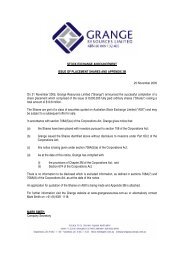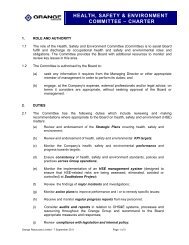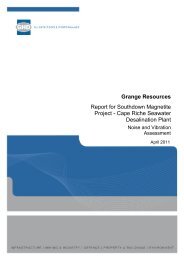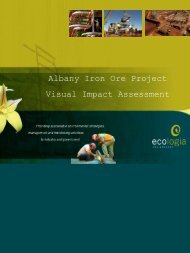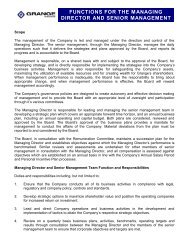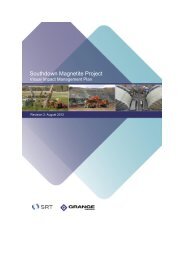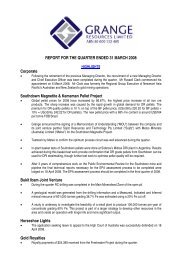Appendix A - Flora and Fauna Survey - Grange Resources
Appendix A - Flora and Fauna Survey - Grange Resources
Appendix A - Flora and Fauna Survey - Grange Resources
Create successful ePaper yourself
Turn your PDF publications into a flip-book with our unique Google optimized e-Paper software.
As the Project will be constructed over a short time period, the effect of habitat degradation is expected<br />
to be minimal. Also, as the alignment is largely adjacent to existing roads <strong>and</strong> highways, species present<br />
are expected to be tolerant of background disturbances.<br />
5.1.5 Dieback <strong>and</strong> weeds<br />
The Study Area is susceptible to dieback, which can be introduced or spread through the movement of<br />
materials particularly during the construction phase.<br />
An increase in bare ground <strong>and</strong> open areas will favour weedy species, which can suppress the<br />
regeneration of native species <strong>and</strong> reduce the available habitat for native species.<br />
Vehicles, machinery <strong>and</strong> materials also have the potential to introduce new weeds <strong>and</strong> disease into the<br />
area, <strong>and</strong>/or facilitate the spread of disease/weeds.<br />
5.2 Mitigation Measures<br />
Potential impacts should be managed through Construction Environmental Management Plans/Project<br />
Environmental Management System (CEMP <strong>and</strong> PEMS), that include but are not limited to the<br />
management measures presented in Table 4.<br />
Given the extent of native vegetation requiring clearing (15.9 ha) <strong>and</strong> presence of similar habitats within<br />
the broader area, the project is not expected to result in significant impacts to conservation significant<br />
species or communities, or to the biodiversity of the local or regional area. Furthermore, with appropriate<br />
management, the residual impacts of the Project on flora <strong>and</strong> fauna are considered to be relatively minor<br />
<strong>and</strong> localised.<br />
Table 4 Management measures<br />
Aspect Potential Impact Mitigation Measure<br />
Vegetation <strong>and</strong> <strong>Flora</strong><br />
Vegetation<br />
Clearing,<br />
Construction<br />
<strong>and</strong> Operation<br />
Loss in local <strong>and</strong> regional<br />
representation of flora <strong>and</strong><br />
fauna communities.<br />
Vegetation <strong>and</strong> flora management will be addressed in<br />
a CEMP, which will include measures to:<br />
� Minimise clearing through site selection <strong>and</strong><br />
design <strong>and</strong> construction options.<br />
� Clearing extents or areas to avoid will be<br />
clearly marked on site plans <strong>and</strong> in the field.<br />
� Priority flora will be avoided <strong>and</strong> protected<br />
wherever possible.<br />
� Management measures should be<br />
implemented to ensure clearing does not<br />
cause appreciable l<strong>and</strong> degradation, including<br />
preventing erosion from the cleared areas.<br />
Management measures should be implemented to<br />
prevent impacts on adjacent flora <strong>and</strong> fauna from<br />
pollution, such as litter <strong>and</strong> oil spills.<br />
26



